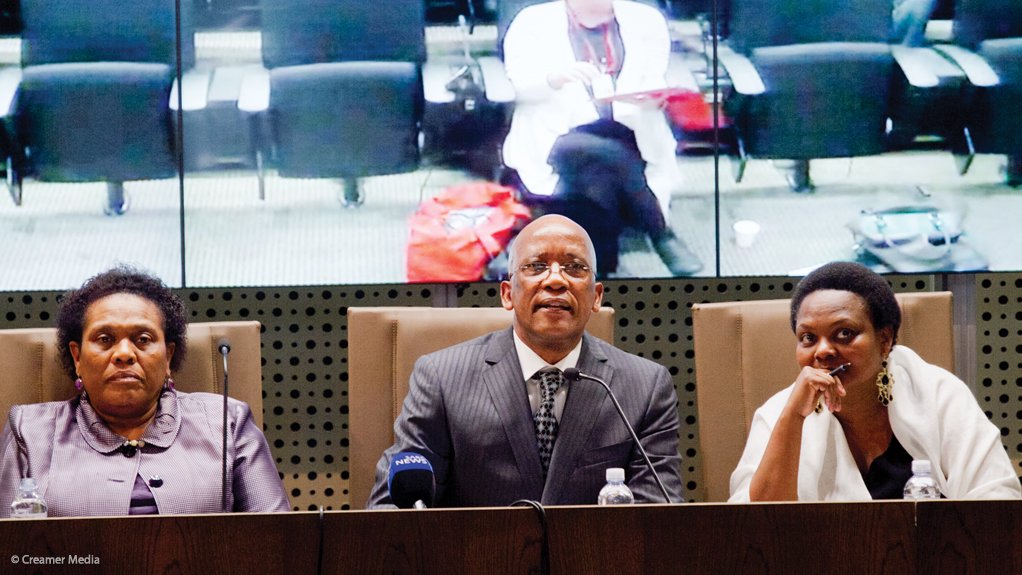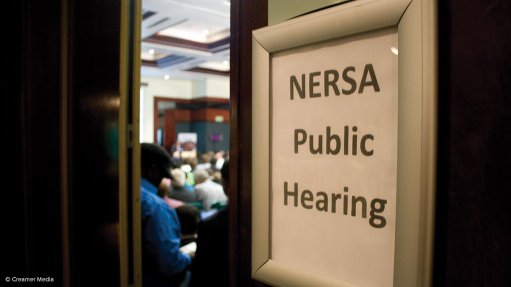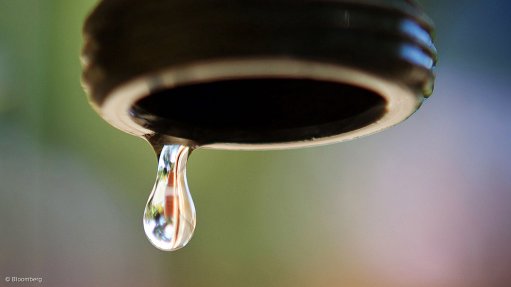Martins yet to determine whether Eskom or an IPP will build ‘Coal Three’


Deputy Energy Minister Barbara Thompson, Energy Minister Dikobe Ben Martins andDepartment of Energy director-general Nelisiwe Magubane
Photo by Duane Daws
Recently appointed Energy Minister Dikobe Ben Martins is yet to determine whether the next coal-fired power generation capacity – a project that has been widely dubbed ‘Coal Three’ – is to be built by State-owned electricity utility Eskom, or by an independent power producer (IPP).
Department of Energy (DoE) director-general Nelisiwe Magubane reports that the most recent Cabinet lekgotla determined only that new coal-fired capacity would be required beyond that being developed currently by Eskom at the Medupi and Kusile sites, in Limpopo and Mpumalanga respectively. But she stressed that Cabinet had not been prescriptive in outlining which entity should be responsible for construction and operation of the new plant.
Sharing a podium with Martins and Deputy Energy Minister Barbara Thompson at a briefing in Pretoria, Magubane said: “Cabinet did not say that Eskom is going to build [Coal Three]”.
“In terms of the law . . . it is the Minister of Energy’s responsibility to decide who builds and who buys. So, all Cabinet did was to express an opinion that energy constraints need to be alleviated. However, they left the responsibility of who finally builds Coal Three, or whatever we call it, to the Minister of Energy – he is going to be applying his mind to that.”
Should Eskom be mandated to build the power station, government and the utility would need to deliberate on the financing model, particularly in light of the Eskom’s balance-sheet constraints and the fact that it had already been declared the owner/operator of any new nuclear plants that could be built in South Africa in future.
Magubane’s statement could account for the mixed message on Coal Three delivered by Eskom CEO Brian Dames and Public Enterprises Minister Malusi Gigaba during a briefing in September.
Dames welcomed the Cabinet announcement and said the project’s endorsement would provided it with the time it required to make adequate preparations for the development. However, he said it was premature to offer details as to where the project could be located, what technology and contracting model would be employed and how the project could be funded.
Gigaba was equivocal on what Cabinet’s decision actually meant, saying government had indicated that it would, in due course, make an announcement on Coal Three to ensure that South Africa did not, by 2017/18, run into problems similar to those experienced ahead of the current build programme.
“So the issue of Coal Three, at the level of Cabinet, is being thought of quite seriously,” he said, while adding that there was the possibility that other new domestic and regional capacity could be sufficient to “alleviate the pressure”.
Magubane stressed that the only Ministerial determinations relating to new baseload capacity had been published in December 2012. These determinations outlined plans for the procurement of new generation capacity from coal, gas, industrial cogeneration facilities and regional and domestic hydropower plants.
The determinations included IPP baseload allocations and allocations arising from the Medium-Term Risk Mitigation (MTRM) plan – both of which have been catered for under the current version of the Integrated Resource Plan, which is in the process of being revised.
Under the MTRM determination, the DoE is seeking to procure 800 MW of near-term cogeneration capacity, which could arise from biomass, industrial waste and combined heat and power sources. It is also aiming to secure 474 MW from natural gas projects.
Under the baseload determination, 2 500 MW has been allocated to coal-fired IPP projects, 2 652 MW to baseload or mid-merit natural gas capacity and 2 609 MW to domestic and imported hydroelectricity prospects.
The DoE was in the process of appointing transaction advisers to assist it in developing a framework for the procurement of that capacity.
“I wouldn’t like us to be too hung up on the words, but the bottom line is that the Cabinet has indicated that we are going to need additional capacity and in support of that we are engaging the transactions advisers,” Magubane concluded.
Comments
Announcements
What's On
Subscribe to improve your user experience...
Option 1 (equivalent of R125 a month):
Receive a weekly copy of Creamer Media's Engineering News & Mining Weekly magazine
(print copy for those in South Africa and e-magazine for those outside of South Africa)
Receive daily email newsletters
Access to full search results
Access archive of magazine back copies
Access to Projects in Progress
Access to ONE Research Report of your choice in PDF format
Option 2 (equivalent of R375 a month):
All benefits from Option 1
PLUS
Access to Creamer Media's Research Channel Africa for ALL Research Reports, in PDF format, on various industrial and mining sectors
including Electricity; Water; Energy Transition; Hydrogen; Roads, Rail and Ports; Coal; Gold; Platinum; Battery Metals; etc.
Already a subscriber?
Forgotten your password?
Receive weekly copy of Creamer Media's Engineering News & Mining Weekly magazine (print copy for those in South Africa and e-magazine for those outside of South Africa)
➕
Recieve daily email newsletters
➕
Access to full search results
➕
Access archive of magazine back copies
➕
Access to Projects in Progress
➕
Access to ONE Research Report of your choice in PDF format
RESEARCH CHANNEL AFRICA
R4500 (equivalent of R375 a month)
SUBSCRIBEAll benefits from Option 1
➕
Access to Creamer Media's Research Channel Africa for ALL Research Reports on various industrial and mining sectors, in PDF format, including on:
Electricity
➕
Water
➕
Energy Transition
➕
Hydrogen
➕
Roads, Rail and Ports
➕
Coal
➕
Gold
➕
Platinum
➕
Battery Metals
➕
etc.
Receive all benefits from Option 1 or Option 2 delivered to numerous people at your company
➕
Multiple User names and Passwords for simultaneous log-ins
➕
Intranet integration access to all in your organisation



















